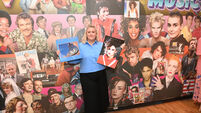Ireland skipper Niamh Briggs welcomes Six Nations bonus point system

“Obviously it’s going to open up the game, you’re going to get people running the ball a lot more,” Briggs said. “But I don’t think it’s going to affect women’s rugby hugely because we don’t kick the ball as much as men.
“We look to run the ball already, we want to play that style anyway and, if it makes for a more exciting brand of rugby, then I’m all for it,” said the woman who captained Ireland in the recent Autumn series, including last weekend’s defeat by the Black Ferns.
“It could make the game more defensive-minded and more like rugby league because you won’t want to be conceding points, but we’ll see how it develops,” said Briggs, who was one of the guest speakers at a major conference on women in sport in Dublin yesterday.
The issue of how to correct the small numbers of women who go into coaching and make it onto sporting boards, was one of the issues discussed, and Briggs firmly came down against the introduction of gender quotas to correct the imbalance.
“From an athletes’ perspective I’d find that annoying,” she said. “Obviously I’d love to see people like Fiona Coghlan and Lynn Cantwell coaching in future but I don’t want them unless they’re good enough to do it. Athletes don’t always make the best coaches.
“We have some female refs already that are not always the best. If people are fast-tracked just because of their gender, that’s a little frustrating for players.”
Paralympic medallist Ellen Keane and Irish soccer international Louise Quinn also gave an elite athlete’s perspectives on the many issues surrounding girls and women in sport.
Organiser Rob Hartnett of Sport For Business said that a straw poll of attendees found that almost (68%) felt that most work needs to be done at schools.
Swimmer Keane (21), who won SB8 breaststroke bronze in Rio in September, pointed to the substantial drop-off in participation levels among girls in secondary schools, saying “our PE class was in the middle of the day and no one wanted to sit and be sweaty for the rest of the day”.
She said she initially had some body image issues due to her disability but that sport was crucial to helping her overcome them and has the potential to do the same for all young girls.
“The more people see, the less they will judge. It’s the same for Paralympic sport as it is for women in sport,” Keane said.
The keynote speakers at the event were Sally Hancock and Sally Horrox of UK agency Y Sport.
Hancock is also chair of Britain’s voluntary ‘Women in Sport’ organisation which has been responsible for establishing the UK’s ‘Women in Sport week’, a movement that has resulted in much more visibility and debate about the issues for women in sport.
They said that intervention at the top end, and improving the infrastructures at the bottom end of some sports, have been two effective strategies for change across the channel.
One such intervention, in the wake of London 2012, was the BBC appointing an editor specifically to monitor women’s sports coverage across all their platforms and setting a target that 10% of their total coverage would be of women’s sport, something they have largely achieved, though not always through live coverage.
Some British sports have also successfully linked increased participation rates with specific events, like English women’s rugby recently re-branding itself as the ‘Red Roses’ and committing to doubling its current participation figures of 25,000 by 2020.
It was pointed out that Ireland is hosting two major women’s international events next year — the Rugby World Cup (August 9-26) and basketball’s European U18 Championships (August 4-13) — which offers great opportunities for change.
Horrox also pointed out that ‘women only’ events have a high success rate in attracting more female participants.
Cycling Ireland has improved its participation rates— 92% male, 8% female in 2008 to 80:20 today — using women’s only events and Irish rowing has also seen a huge growth in female participation via a similar initiative.
The most recent research in Britain showed that only 15% of girls aged 11-15 do enough exercise to be healthy.











